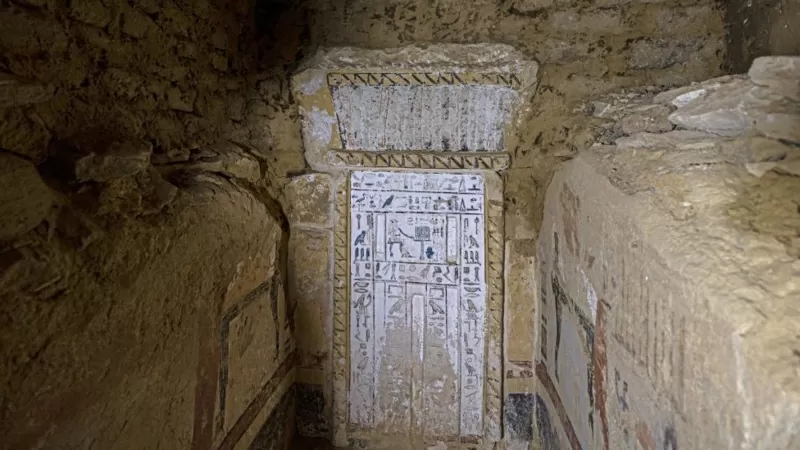Ancient Egypt: A 4,300-year-old mummy covered with gold foil was found among archaeological discoveries in Saqqara

One of the four tombs discovered recently in the archaeological area of Saqqara, south of Cairo
Egyptian archaeologists say they have found a mummy covered in gold foil inside a sealed, untouched sarcophagus 4,300 years ago.
It is believed that the mummy, which is of a man named "Haka Sheps", is one of the most complete and oldest non-royal mummies found so far in Egypt.
Scientists found the mummy in a chamber at the bottom of a 15-meter-deep well at a burial site in the Saqqara region, south of Cairo, where three other tombs were found.
One of these tombs is for a person who bears the title of "Keep Al-Asrar".
Scientists said that they had found a tomb of a man named "Khnum Gedf", who worked as a priest, inspector and supervisor of the nobles.
Another tomb was found for a man named "Mari", who was a high-ranking official in the palace, and bore the title "Keeper of Secrets", which allowed him to perform special religious rituals.
Archaeologists believe that a person named "Fatak", who worked as a judge and writer, was buried in another cemetery, where a group believed to be the largest group of stone statues found so far in the region was discovered.
Numerous other belongings were also found in the area, including pottery.

Scientists found statues and various pottery vessels in the tombs
Archaeologist Zahi Hawass, the former Egyptian Minister of Antiquities, said that all the discoveries date back to around the 25th to the 22nd century BC.
Ali Abu Dashish, an archeologist and one of the excavations, said: "This discovery is very important because it connects the kings with the people who lived around them."
Saqqara has been a place to bury the dead for more than 3,000 years, and it is a UNESCO World Heritage Site. It is located in what was known as the ancient Egyptian capital, Memphis, and includes more than ten pyramids, including the step pyramid of Djoser, which is located near the well. Under which the mummy was found.
Thursday's discovery comes just one day after antiquities experts in the city of Luxor, in southern Egypt, announced their discovery of an entire residential city belonging to the Roman era, in the second and third centuries AD.
The scientists discovered residential buildings and towers, and what they called "metal smelting and manufacturing workshops", inside which they found a number of Roman utensils, tools and coins.
Egypt has announced several notable archaeological discoveries in recent years, as part of efforts to revive its tourism industry.
The government hopes the Grand Egyptian Museum, due to open this year after delays, will attract 30 million tourists annually by 2028.
However, opponents criticize the Egyptian government for giving priority to the discoveries, which capture the attention of the media, at the expense of interest in difficult academic scientific research, in order to attract more tourism.
Source : websites

